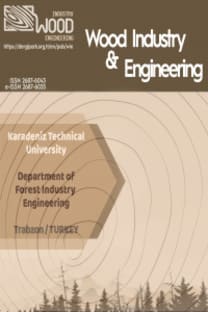OPTIMIZATION OF MECHANICAL PROPERTIES OF HYBRID BIOCOMPOSITE FROM STERCULIA SETIGERA DELILE FIBRE AND PTEROCARPUS ERINACEUS WOOD DUST EPOXY
OPTIMIZATION OF MECHANICAL PROPERTIES OF HYBRID BIOCOMPOSITE FROM STERCULIA SETIGERA DELILE FIBRE AND PTEROCARPUS ERINACEUS WOOD DUST EPOXY
Synthetic fibres have been used for the production of high strength composite material of low density for various aerospace and automotive applications. The problem with synthetic fibres includes high energy consumption during processing, high cost, non-biodegradability and environmental pollution during production and disposal. Natural fibre reinforced composites have been explored as potential replacement for synthetic fibres. The research explores the use of Wood fibre reinforcement such as Sterculia Setigera Delile fibre sourced from a durable inner tree bark and Pterocarpus Erinaceus wood dust from high quality wood for the production of a hybrid composite material with epoxy as the matrix. The aim is to produce a Novel Hybrid material with high tensile, flexural and compressive strength, low density and high thermal stability. Taguchi method was used for the design of experiment and the optimization of factors affecting the tensile, flexural and compression strength of the composite. The factors include alkaline treatment (Hot, Cold and Untreated), SSD fibre content (2.5, 5, 7.5, 10, 12.5) wt.%, Pterocarpus Erinacues wood dust content (0, 2.5, 5, 7.5, 10)wt.% and fibre angular orientation (0, 15, 30, 45, 90o). The result showed that the optimum composite parameters consist of 5% Cold Alkaline treated 5% SSD fibre with 7.5% PTE wood dust at 0-degree orientation. The thermal stability of the composite was also improved by the addition of the reinforcements. Factors such as fibre angular orientation and alkaline treatment were significant factors. The optimized composite improved the tensile strength of the composite when compared to the Epoxy Matrix by 105.9% and also improved the flexural strength by 94.91%. The optimized composite has a lower density (1.093g/cm3) when compared to carbon-epoxy composite (1.6g/cm3) and S-glass fibre epoxy composite (1.9g/cm3). The optimized composite would have better Biodegradability, lighter weight means lower energy consumption and cost when used in aerospace and automobile components.
Keywords:
Epoxy Matrix, Taguchi method, ANOVA, Fibre angular orientation, Thermal stability Pterocarpus erinaceus Wood Dust, Alkaline Treatment, Sterculia setigera delile Fibre,
___
- References 1. Adelakun, KM, Mustapha, MK, Ogundiwin, DI and Ihidero, AA (2014) Nutritional and anti-nutrient composition of Karaya gum tree (Sterculiasetigera) seed: a potential fish feed ingredient. Journal of fisheries 2(3): 151-156.
- 2. Anthonio, F and Antwi-Boasiako, C (2017) The Characteristics of Fibres Within Coppiced and Non-Coppiced Rosewood (PterocarpuserinaceusPoir.) And Their Aptness For Wood - And Paper – Based Products. Proligno 13(2):27-39.
- 3. ASTM International (2015) ASTM D695-15: Standard Test Method for Compressive Properties of Rigid Plastics. West Conshohoken, PA: American Society for Testing Materials.
- 4. ASTM International (2017) ASTM D790: Standard Test Methods for Flexural Properties of Unreinforced and Reinforced Plastics and Electrical Insulating Material. West Conshohoken, PA: American Society for Testing Materials.
- 5. ASTM International. (2017) ASTM D3039: Standard Test Method of Polymer Matrix Composite Material. West Conshohoken, PA: American Society for Testing Materials.
- 6. Azwa, Z. and Yousif, B (2013) Characteristics of kenaf fibre/epoxy composites subjected to thermal degradation. Polymer Degradation and Stability, 98(12): 2752-2759.
- 7. El-Bassir, A, Mohamed, OM and Hamdins, NI (2015). SterculiaSetigera Seeds as Food for Tilapia Fish (Oreochromisniloticus) Finger lings. European Academic Research, 3(2):1571-1586.
- 8. Hanan, F., Jawaid, M. and Tahir, P. M. (2018). Mechanical performance of oil palm/kenaf fiber-reinforced epoxy-based bilayer hybrid composites. Journal of natural fibres, 1-13.
- 9. Mehra, A., Saini, R. and Kumar, A. (2021). The effect of fibre contents on mechanical and moisture absorption properties of gourd sponge/coir fibre reinforced epoxy hybrid composites . Composites Communications, 25, 1-8.
- 10. Ogunwusi, AA and Ibrahim HD (2016). Industrial Potential of Underutilized Plant in Nigeria. Journal of Natural Science Research 6(6): 20-28.
- 11. Okafor, E, Ihueze, CC and Nwigbo SC (2013) Optimization of Hardness Strengths Response of Plantain Fibers Reinforced Polyester Matrix Composites (PFRP) Applying Taguchi Robust Design. International Journal Of Engineering, 26(1): 1-11.
- 12. Sanjay, MR, Arpitha, GR, Naik, LL, Gopalakrishna, K and Yogesha, B (2016). Applications of Natural Fibers and Its Composites: An Overview. Natural Resources, 7:108-114.
- 13. Trehan, R, Singh, S and Garg, M (2013). Optimization of mechanical properties of polyester hybrid composite laminate using Taguchi methodology – Part 1. Proceedings Of The Institution Of Mechanical Engineers, Part L:Journal Of Materials: Design And Applications, 229(4): 263-273.
- 14. Roy, R (2010) A primer on the Taguchi method. Michigan: Society of Manufacturing Engineers
- ISSN: 2687-6043
- Başlangıç: 2017
- Yayıncı: Karadeniz Teknik Üniversitesi
